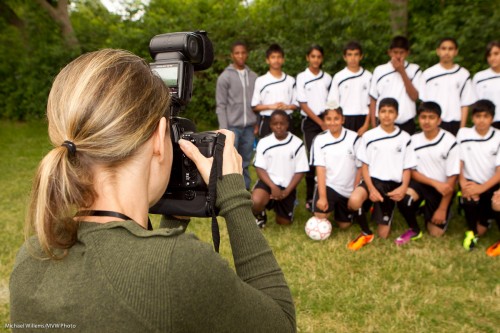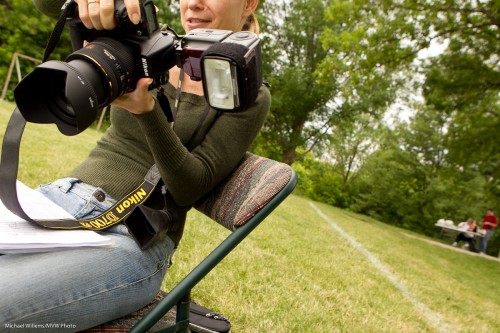My 1,001th post is once again about speedlights – appropriately, you might say.
Yesterday and today, I shot outdoors, with my Canon cameras – and with my second shooter who shoots Nikon. A wedding Saturday and soccer kids Sunday.
And that shooting experience prompts me to say a few things about exposure and flash on Canon and Nikon systems.
And as I was explaining today, it struck me again how complex these systems are if you try to understand them all at once. So I will be discussing them bit by bit, in easily digested parts. The big picture will be clear once you get all the parts. But you always start with the parts, and use deductive reasoning to get the the bigger picture.
So, let’s start with some simple definitions, today. Just to make sure you are all on the same page.
A picture like the one above uses (really, mixes) two types of light:
- Available, or ambient, light. From the sun, in this case.
- Flash light. From, um, the flash.
Each can appear light or dark in your image:
- If the ambient light appears dark in your picture, this makes for a dark background.
- If the flash light appears dark this can make for a dark foreground subject.
- If the ambient light appears dark, the flash may be the main source of light on your subject, and when using just one flash, you can get a harsh look.
- If the ambient light appears bright, the flash will not add much.
Both ambient and flash can be adjusted – by you or by the camera.
Ambient light:
- Manual exposure means you are setting the ambient brightness entirely by yourself. You do this by adjusting ISO, Aperture and Shutter. You use “M” mode for this and ensure auto ISO is off.
- Automatic exposure means the camera is setting the ambient brightness. It does that in P, S/Tv amd A/Av modes.
Flash light:
- Manual flash is when you set the flash power level (really, its time) yourself. The flash displays “M” at the back. You set the power fo 1/1 or 100%, or to 1/2 or 50%, or to 1/4th or 25%, and so on. You would do this in a studio.
- Automatic flash is when the camera sets the flash power level – usually in what we call “TTL” mode. It uses a preflash for this in TTL mode. You would use this at, say, a party.
Getting confused yet?
Then we make it more confusing.
In automatic modes, you can nevertheless adjust the brightness of various parts of your image.
And this is the subject of today’s post: when doing this, Canon and Nikon behave differently.
On a Canon camera, you use:
- Exposure compensation to modify the brightness of the ambient part of the image from what your camera had in mind. Plus means brighter, minus means darker.
- Flash exposure compensation to modify the brightness of the flash part of the image from what your camera had in mind. Plus means brighter, minus means darker.
On a Nikon camera, you use:
- Exposure compensation to modify the overall brightness of the picture (i.e. the flash part as well as the ambient part) of the image from what your camera had in mind. Plus means brighter, minus means darker.
- Flash exposure compensation to modify the brightness of only the flash part of the image from what your camera had in mind. But it does not always work. Plus means brighter, minus means darker.
You can set exposure compenstion by pressing and holding the “+/- button” or -dial. You set flash compensation on the flash or on the camera – but if you do it on the flash, that overrules what you do on the camera.
In the next days and weeks I will touch upon these concepts some more. But let’s start here.


